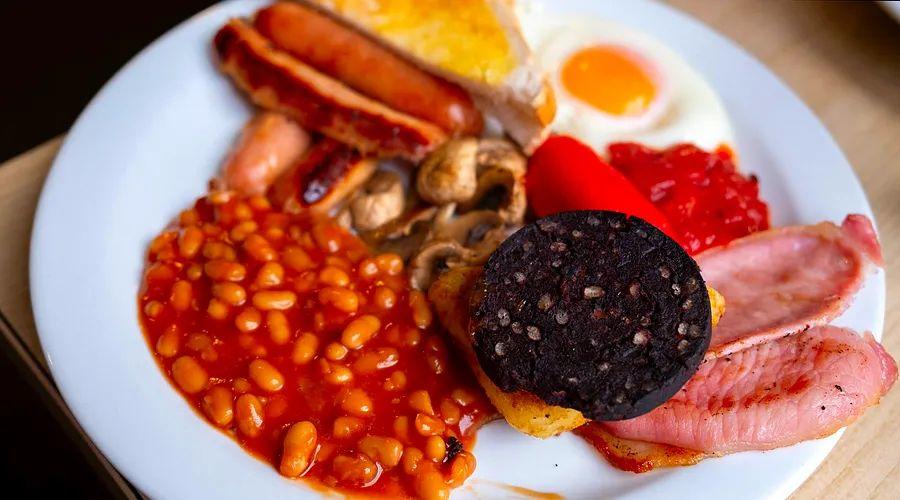The Full English: How a greasy meal became a symbol that both unites and divides a nation

Picture something quintessentially British. Now imagine it dialed up a notch. Were you thinking of the Beatles crossing Abbey Road? Now imagine their iconic album cover recreated with the elements of a full English breakfast.
In 2012, food artist Paul Baker recreated this exact scene. John becomes the (scrambled) eggman, while vegetarian Paul is made entirely of mushrooms. Abbey Road is reimagined with baked beans, a bacon Volkswagen Beetle on the side. Slabs of white and brown toast form the famous crosswalk.
In a single stroke of edible absurdity, Baker’s creation showcases the cultural significance of the full English breakfast. Consumed in the nation’s greasy spoon diners and motorway pit stops — and even some of its poshest hotels and restaurants — this hearty mix of bacon, eggs, sausage, and various other cooked ingredients (always paired with a steaming mug of tea or coffee) has become a symbol of Britishness.
It’s as iconic as the Beatles, if not more. Like ‘Abbey Road,’ the full English — or ‘fry-up,’ ‘full monty,’ or ‘cooked breakfast’ — is adored as a culinary masterpiece, yet also criticized by some for being overly chaotic and indulgent.
So where did the full English come from? How did it become the epitome of British identity? And come to think of it, what exactly does it entail?
The history behind the full English breakfast
In the past, English breakfasts were quite simple. For Britain’s Roman invaders, it was the least significant meal of the day. Their Norman conquerors were content with a piece of bread and a sip of weak ale to start the morning.
It’s true that meat sometimes graced the morning table (in 1662, diarist Samuel Pepys recorded ‘a breakfast of cold roast beef’), but the full fry-up didn’t really take shape until the Victorians. As Kaori O’Connor notes in ‘The English Breakfast,’ ‘Large breakfasts were unheard of in English life or cookbooks until the nineteenth century, when they emerged with surprising speed.’
It was in the grand country estates that these leisurely, buffet-style breakfasts first appeared — the kind immortalized in shows like the Edwardian drama ‘Downton Abbey,’ where diners help themselves to hot dishes served in silver chafing dishes.
Aristocratic socialite and writer Lady Cynthia Asquith reminisced about breakfasts with ‘crispy, curly bacon, eggs (poached, boiled, or fried), heaps of moist kedgeree (made with salmon), haddocks drenched in butter, sizzling sausages, and kidneys glowing with a rich, ruddy hue.’
Beyond being a lavish display of wealth, as O’Connor writes, the English breakfast was also a proudly patriotic response to the French, known for their love of hors d’oeuvres: ‘The French had no such thing as a proper breakfast… So breakfast became the heart of Englishness, and emerged as the nation’s meal of choice.’

The middle class quickly took to it, aided by the rise of celebrity cook and domestic expert Isabella Beeton. In 1861, Beeton published her ‘Book of Household Management,’ featuring recipes for breakfast staples like ‘fried ham and eggs’ and ‘broiled rashers of bacon.’
A new trend emerged in the publishing world: ‘The Breakfast Book’ (1865), ‘Handbook for the Breakfast Table’ (1873), ‘Breakfast and Luncheon at Home’ (1880), and ‘Breakfast Dishes for Every Morning of Three Months’ (1884). In 1874, the Edinburgh Evening News featured ‘An English Farmer’s Breakfast,’ describing rashers of bacon ‘bubbling with grease and served on thick slices of bread.’
Other publications of the era featured ads for bacon and sausages. An 1890 ad in The Blyth Times promoted ‘first-class breakfast bacon’ from Thompson’s English rolled flitch. By 1921, Lady Jekyll wrote in The London Times that ‘no breakfast table is complete without eggs and bacon.’
What exactly defines a full English breakfast?
It’s easier said than done to define what constitutes a full English breakfast.
While some traditional components (like fish, marmalade, and kidneys) gradually faded from the plate, others were added. Heinz beans — the canned haricot beans in tomato sauce now seen as a key part of the fry-up — were introduced in 1886, when young entrepreneur Henry Heinz sold five cases to the London department store Fortnum & Mason. ‘I think, Mr. Heinz, we’ll take the lot!’ they said.
HP Sauce — a tangy brown concoction, its bottle adorned with the iconic Houses of Parliament — made its debut in 1895, and has been drenching sausages across the UK ever since. The full English breakfast reveals its true variety when viewed through the window of any greasy spoon, where you’ll find variations like:
‘Set 1: Egg, Bacon, Beans, Sausage, 2 Toast, Tea or Coffee’
‘Set 2: Egg, Tomato, Sausage, Mushroom, 2 Toast, Tea or Coffee’
‘Set 3: Egg, Bacon, Tomato, Sausage, Mushroom, Toast, Chips, Tea or Coffee…’

It’s a never-ending riddle, like a genius attempting to crack a calorific Enigma code. The complexity of a fry-up expands when you consider its Celtic relatives: the full Scottish (featuring haggis and the distinctive square Lorne sausage), the full Irish or Ulster fry (often with soda bread and white pudding rather than black), and the full Welsh (where the unexpected laverbread and fresh cockles take center stage).
Even more confusingly, despite being called a fry-up, not all of the ingredients are necessarily fried these days.
At least some elements of the breakfast are predictable. Sausage, bacon, and eggs are standard, as is some form of bread to soak up the remnants. Black pudding (or blood pudding, beloved by the late Anthony Bourdain), mushrooms, tomatoes (whether fresh or tinned), and chips are common, though often left to the diner’s discretion.
Every Brit has their own ideal combination of ingredients, each with their personal take on how each component should be prepared. Eggs might be fried, poached, or scrambled. Bacon could be smoked or unsmoked. Bread might be fried, toasted, or simply left plain. A spoonful of tomato ketchup or brown sauce may or may not accompany the plate.
In the sitcom 'I’m Alan Partridge,' the self-important radio host gives a pompous review of his Ukrainian girlfriend’s attempt at preparing a cooked breakfast:
‘Bacon, 10 out of 10. Button mushrooms, spot on. Black pudding, nailed it. Small issue — the eggs and beans need more space. I might want to mix them, but I should have the option. Use the sausage as a barrier. But I’m nitpicking. Overall, a very good effort. Seven out of 10. Now, let’s make love.’
Some ingredients, however, should be banned entirely, says Guise Bule from the English Breakfast Society, a group dedicated to preserving the history and traditions of the full English. ‘Reconstituted potato hash browns are a lazy substitute for bubble and squeak,’ he declares with authority. Onion rings, another recent addition to British breakfast plates, are seen by many purists as an unforgivable sacrilege.

Such criticism doesn’t apply to the Dalby Cafe in Margate, Kent, which gained viral fame after local rock legend Pete Doherty managed to demolish its notorious ‘mega breakfast’ in under 20 minutes, securing his spot on the legendary ‘wall of fame.’ Who knew rock ‘n’ roll could compete with biting off bat heads?
The Modern Fry-Up
Like many British innovations — the flush toilet, the iron bridge, the hovercraft — the fry-up hasn’t always had an easy path. World War II's harsh food rationing dealt a significant blow, and it took years for the fry-up to make a full recovery.
However, as mass-produced foods like sausages, factory-farmed eggs, and sliced bread surged in the 1950s, the full English breakfast became an obsession across the nation. Any cafe or hotel worth its name served it. Brits visiting Spain’s Benidorm and Majorca demanded their eggs and bacon served by the beach. In 1953, a gang of burglars broke into a west London school, but still took time to fry eggs and make tea.
In today’s era of kale smoothies and overnight oats, the beloved breakfast faces a new challenge. ‘To eat well in England,’ playwright Somerset Maugham famously said, ‘you should have breakfast three times a day.’ But studies show younger Brits now only have a full English a couple of times a year. In a society increasingly focused on health (and time-saving), some are beginning to wonder if the iconic fry-up is fading from popularity.
If that’s the case, British society seems determined to keep it well-hidden. TV airwaves are flooded with endless reruns of ‘Four in a Bed,’ a budget reality show where bed-and-breakfast owners critique each other’s duvet cleanliness and the quality of their English breakfasts. Seaside towns sell tiny English breakfasts in the form of hard candy, while on almost every high street, low-cost pub chain Wetherspoon serves up bacon, sausage, and eggs for as little as £2.99.

At the opposite end of the dining spectrum, where Gordon Ramsay might have missed the mark, others are hitting it perfectly. After a public outcry, the Hawksmoor restaurant chain brought back its celebrated English breakfast, which had been briefly discontinued. ‘We’ve never been flooded with so many requests to bring something back,’ says Huw Gott, co-founder of Hawksmoor.
Every Saturday, Hawksmoor locations in London, Edinburgh, and Liverpool serve up 50-80 plates stacked with a hearty mix of sugar-cured bacon chop, Victorian-style sausages, Moira black pudding, hash browns, grilled bone marrow, trotter beans, fried eggs, grilled mushrooms, roasted tomatoes, endless toast, and HP Sauce gravy. ‘Warning,’ reads the dish’s tagline, ‘Not for the faint-hearted.’
Rather than just being a posh version of Dalby Cafe’s artery-clogging breakfast challenge, Hawksmoor’s offering celebrates the roots of the traditional English breakfast. ‘We use a recipe from the Victorian era for our sausages, made with a blend of pork, beef, and mutton, seasoned with an abundance of herbs and spices,’ says co-founder Huw Gott.
Meanwhile, the English breakfast continues to evolve, as it always has. In April 2024, appliance giant Breville launched a pop-up called the ‘Grease-Less Spoon,’ demonstrating how breakfast ingredients could be cooked more healthily in an air fryer. Vegetarian and vegan options are now appearing on many breakfast menus. A brand founded by the late Linda McCartney, wife of Paul McCartney, has become a popular supplier of meat-free sausages, which often find their way onto breakfast plates.
Another sign of the fry-up’s enduring popularity is the fact that people are still ordering it.

‘We get visitors from all over the globe coming here in search of the perfect British breakfast,’ says Huw Gott of Hawksmoor. Social media has only amplified this growing global interest.
On platforms like TikTok, attempts are made to put a unique spin on the classic British breakfast. Recently, American food personality Adam Richman, famous for ‘Man Vs Food,’ visited Bury Market in northern England to sample the renowned black pudding from Chadwick’s.
The English breakfast was conceived as a statement — and it still holds that status. It’s a hearty emblem of British culture, a tempting draw for tourists, and often a subject of curiosity. Foreigners may try (and sometimes fail) to recreate it, but they always come away impressed and appreciative.
As long as there is tourism in Britain, the fry-up will continue to be a fixture. Just as British holidaymakers flock to Benidorm, the familiar smell of sizzling bacon will undoubtedly linger in the air on the seafront.

1

2

3

4

5
Evaluation :
5/5